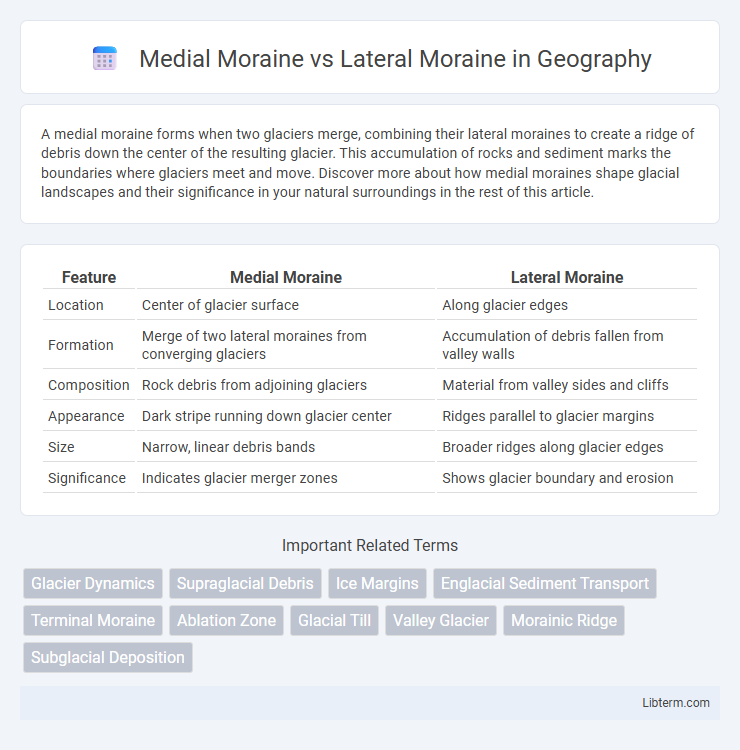A medial moraine forms when two glaciers merge, combining their lateral moraines to create a ridge of debris down the center of the resulting glacier. This accumulation of rocks and sediment marks the boundaries where glaciers meet and move. Discover more about how medial moraines shape glacial landscapes and their significance in your natural surroundings in the rest of this article.
Table of Comparison
| Feature | Medial Moraine | Lateral Moraine |
|---|---|---|
| Location | Center of glacier surface | Along glacier edges |
| Formation | Merge of two lateral moraines from converging glaciers | Accumulation of debris fallen from valley walls |
| Composition | Rock debris from adjoining glaciers | Material from valley sides and cliffs |
| Appearance | Dark stripe running down glacier center | Ridges parallel to glacier margins |
| Size | Narrow, linear debris bands | Broader ridges along glacier edges |
| Significance | Indicates glacier merger zones | Shows glacier boundary and erosion |
Introduction to Glacial Moraines
Medial moraines form when two glaciers merge, creating a ridge of debris running down the center of the combined glacier, while lateral moraines develop along the edges of a single glacier from debris accumulating at its sides. These glacial moraines are key indicators of past and present glacier activity, consisting primarily of rock, soil, and sediment transported by glacial movement. Understanding the differences between medial and lateral moraines helps geologists reconstruct glacier dynamics and climate history.
Defining Medial and Lateral Moraines
Medial moraines form when two glaciers with lateral moraines converge, creating a continuous ridge of debris in the center of the combined glacier. Lateral moraines develop along the sides of a single glacier, composed of rock and sediment accumulated from the glacier's edges. These distinct formations indicate different glacier dynamics and sediment transport processes, crucial for understanding glacial geology.
Formation Process of Medial Moraines
Medial moraines form when two glaciers converge, causing the lateral moraines from each glacier to merge and create a ridge of debris along the center of the combined glacier. This process involves the accumulation of rock fragments and sediment that were originally deposited along the edges of separate glaciers. Unlike lateral moraines, which form along the sides of individual glaciers, medial moraines represent the fusion of these edge deposits during glacier confluence.
Formation Process of Lateral Moraines
Lateral moraines form along the edges of a glacier where debris accumulates from the valley walls due to frost wedging and rockfall, depositing sediment as the glacier advances and retreats. Medial moraines develop when two glaciers with lateral moraines merge, combining their debris into a ridge down the center of the new glacier. The distinctive formation of lateral moraines reflects their origin from the direct erosion of valley sides, contrasting with the central positioning of medial moraines.
Key Differences Between Medial and Lateral Moraines
Medial moraines form when two glaciers merge, creating a central ridge of debris carried along the middle of the combined glacier, whereas lateral moraines develop along the sides of a glacier as accumulations of rock and sediment from the valley walls. Key differences include their location on the glacier: medial moraines appear between converging ice flows, and lateral moraines run parallel to the glacier margins. The composition of both moraines consists of till, but medial moraines often combine debris from two separate ice sources, providing distinct geomorphological evidence of glacier interaction.
Visual Identification: Medial vs Lateral Moraines
Medial moraines appear as dark, narrow lines running down the center of a glacier, formed by the merging of lateral moraines from two converging glaciers. Lateral moraines are found along the edges of glaciers, consisting of accumulated debris and rocks pushed to the sides during glacier movement. Visually, medial moraines are characterized by their central location and linear shape, while lateral moraines are irregular ridges or mounds along glacier margins.
Geographical Distribution of Moraines
Medial moraines form along the center of a glacier where two glaciers merge, commonly observed in alpine regions such as the Himalayas and the Alps. Lateral moraines develop along the sides of glaciers, frequently found in valley glaciers across North America, including the Rocky Mountains and Alaska. The geographical distribution of these moraines reflects glacier dynamics, with medial moraines indicating glacier confluence zones and lateral moraines marking glacier boundaries.
Environmental Impact of Glacial Moraines
Medial moraines and lateral moraines differ in their formation, with medial moraines forming where two glaciers meet and lateral moraines forming along the glacier edges, both impacting the environment through sediment deposition and habitat alteration. The accumulation of these moraines influences glacial meltwater flow, affecting downstream ecosystems by modifying nutrient distribution and sediment loads. Their presence also contributes to landscape evolution, controlling soil development and vegetation patterns in glacial valleys over time.
Significance in Glacial Landscape Interpretation
Medial moraines form from the merging of lateral moraines when two glaciers converge, providing critical evidence of glacier dynamics and flow patterns in glacial landscape interpretation. Lateral moraines, located along glacier edges, indicate past glacier extent and fluctuations, essential for reconstructing paleoclimate conditions. Analyzing the position and composition of both medial and lateral moraines allows scientists to understand glacier behavior, sediment transport, and landscape evolution in glaciated regions.
Conclusion: Understanding Moraine Types
Medial moraines form when two glaciers merge, creating a ridge of debris along the center of the combined glacier, while lateral moraines develop along the sides of individual glaciers from debris accumulation. Both moraine types reveal crucial information about glacial movement and erosion patterns. Recognizing the distinct characteristics of medial and lateral moraines aids in interpreting past glacial environments and geological history.
Medial Moraine Infographic

 libterm.com
libterm.com